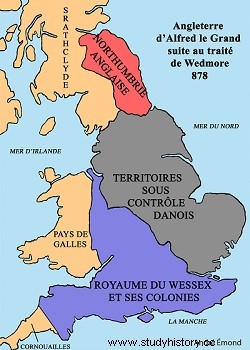
866 – 954
Monarchy status
Jórvík capital
History and events
866 Capture of the city of York by the Vikings
873 Annexation of Mercia
944 York is taken over by Edmund I of England
954 Death of Eric I; the kingdom is annexed to the kingdom of England
Previous entities:
Northumbria
Following features :
Kingdom of England
The Viking kingdom of York existed between 866 and 954. Vikings from Denmark established a potentate dividing the island of Britain, the future Great Britain, with York as its capital, a city they called Jórvík after having invested it . The region around this city is called the Danelaw, a term which also applies to the jurisdiction set up by the Danes until the second half of the 10th century 1
Origins of the kingdom (866-876)
In 865, a large Danish force called the "Great Army", landed in East Anglia and was granted tribute. The army moved north and took advantage of a civil war in Northumbria to take the city of York in November 866. Despite their alliance, the two rival candidates for the throne of Northumbria, Osberht and Ælle, failed to recapture the city in March 867 and, with their death, the kingdom of Deira fell under the control of the Vikings.
In 867 the Vikings attempted to occupy Mercia. Besieged in Nottingham, they are forced to retreat to York. In 869, they raided East Anglia, killed King Edmund and annexed the kingdom. In the same year, their attempts against Mercia and Wessex proved unsuccessful in the face of resistance from Kings Ethelred and Alfred the Great. Mercia was finally taken in 873.
876-918
Since 866, the Vikings had ruled their kingdom through puppet kings when one of the leaders of the "Great Army", Halfdan ascended the throne in 876. He then initiated the project to unify the kingdoms of York and Dublin, but died in 877.
In 910, Halfdan II &Eowils died at the Battle of Tettenhall, weakening the kingdom which was occupied in 918 by Saxon troops from Wessex and Mercia. The same weakness of power allows Rognvald, an adventurer of Norse-Irish descent, to take the throne.
919-954
In 927 King Athelstan manages to drive out the Vikings. Ten years later, Olaf Gudfirdsson tried to retake York by joining forces with the Scots and the Brittonics of Strathclyde. This coalition was defeated at the Battle of Brunanburh. Only the death of Athelstan in 939 allowed Olaf to retake York and subjugate Northumbria and the Five Danelaw Towns.
In 944, King Edmund retook York. Eric Bloodaxe, exiled King of Norway, captured the city in 948, but died in an ambush in 954, ending the Viking kingdom of York for good.
List of Kings of York
866-873:Ivarr Beinlauss;
873-877:Halfdan I;
877-883:Government by Eadulf I of Bernicia Earl of Bamburgh;
883-895:Gudfridr I;
895-899:Sigfrith;
899-900:Knut;
899-902:Æthelwald of Wessex;
902-910:Halfdan II &associated Eowils;
910-921:Rognvald I;
921-927:Sigtryggr Caoch (king of Dublin since 917);
927-927:Gudfridr II (king of Dublin since 920);
927 -939:Athelstan (Adalsteinn), king of Wessex since 924;
939-941:Olaf I Gudfirdsson, king of Dublin since 934;
941-943:Olaf II Kvaran, king of Dublin in 945, expelled;
943-944:Rognvald II Gudfirdsson;
944-944:Olaf II Kvaran (restored);
944-946:Edmund of Wessex, King of Wessex since 939;
946-948:Eadred, King of Wessex (946-956);
948-948:Eric Bloodaxe, King of Norway (930-936), expelled;
949-952:Olaf II Kvaran (restored again);
952-954:Bloodaxe Eric (restored).
